Long before I ever became a birder, the word cuckoo conjured two things: the Three Stooges and cuckoo clocks. I had no idea that the distinctive sound cuckoo clocks make is a perfect imitation of the Common Cuckoo (Cuculus canorus), a bird that German clockmakers would have been very familiar with in the Black Forest when they created this wonderful timepiece. I didn’t know anything about the bird when I took my first Shakespeare classes. He makes reference to this bird, the inspiration behind the word cuckold, fairly often.

The cuckoos of the UK and Europe are in the same family as our American cuckoos, but in a different subfamily, Cuculinae, and the birds are quite different in important ways. The Common Cuckoo is famous for being a brood parasite, meaning females lay their eggs in the nests of other species, and those parents raise the cuckoos instead of their own young. When a Common Cuckoo egg hatches, the tiny hatchling has a powerful instinct to roll out everything else in the nest, including any eggs or chicks belonging to the parents at that nest, so it will soon have no competition at all for every one of both parents’ feedings. American cowbirds are also brood parasites, but although baby cowbirds have a serious size advantage over the natural warblers or sparrows in the nest, the cowbirds aren’t aggressive toward them. In many species such as Song Sparrows, at least two and sometimes three of the parents’ own nestlings survive to fledge along with the baby cowbird. European cuckoos are larger than cowbirds and apparently need all the calories the foster parents can muster.
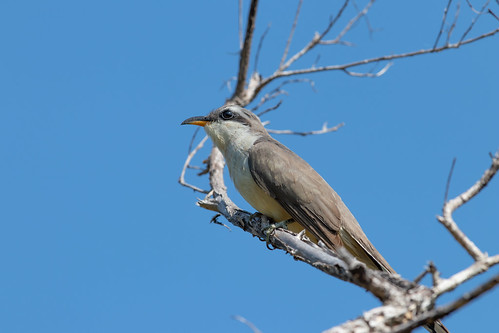 |
| Mangrove Cuckoo |
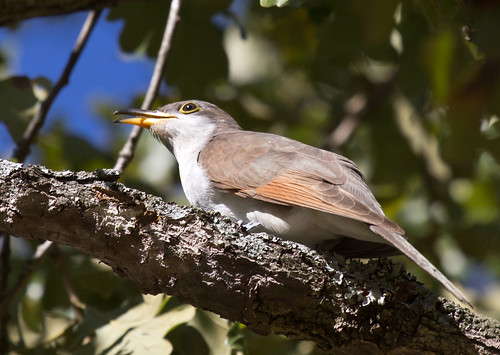 |
| Yellow-billed Cuckoo |
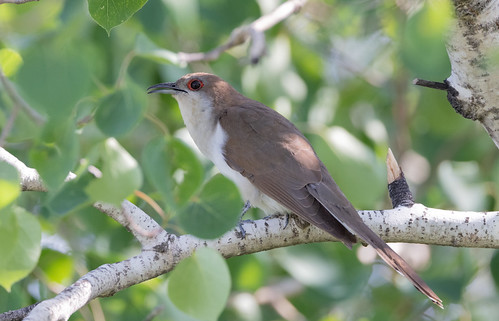 |
| Black-billed Cuckoo |
The three cuckoos found in the United States belong to a different subfamily, Coccyzinae, and are not usually brood parasites (though they sometimes lay eggs in the nests of other birds—cuckoos and other species—in addition to laying eggs in their own nests and raising those young). All three of our cuckoos have distinctive calls but can sit still for many long minutes within foliage, so even when they’re calling persistently, they can be tricky to observe. Although we may work hard to see one at all, none of them seem all that wary, so once you do see one, you can often watch for a while.
The Mangrove Cuckoo, found in the United States only in southern Florida and most easily seen here in the Keys, has a very loud call. This was considered a migratory species that withdrew from Florida in winter back, making it seem to be a rarer find than it really was when I saw my lifer in the Everglades in 1988. The birds don’t call in winter, so even researchers weren’t easily finding them in winter. I lucked into seeing mine only because a little group of Blue-gray Gnatcatchers were mobbing it as I hiked the Snake Bight Trail. It didn’t move a muscle while I studied it—I could only confirm that it was a real, live bird and not a fake or stuffed specimen because it blinked a few times. I've seen Mangrove Cuckoos in the Keys a few times, including on Saddlebunch Key in 2019 when I was with Russ. I got photos while he got a recording with my iPhone.
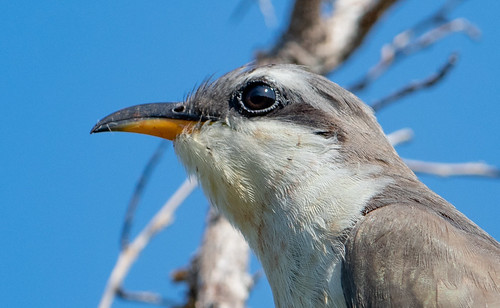 |
| Click here to hear this very bird as recorded on my iPhone. |
Two cuckoos are found in the US north of Florida. The Yellow-billed breeds throughout much of the eastern United States down to South Florida and west into the Great Plains, with isolated, declining populations in the American West, and down into Mexico and the Greater Antilles. It breeds throughout Wisconsin and Minnesota except northeastern-most Minnesota. The Black-billed Cuckoo ranges farther north than the Yellow-billed, but not in the Gulf States nor Mexico or any Caribbean islands. Both species winter in South America.
The Yellow-billed Cuckoo is often called the rain crow because it calls so often on hot days just before a thunderstorm, and its strident call is hard to ignore. The Black-billed Cuckoo is more likely to be seen or at least heard by Northlanders, but only if they’re paying attention. Its calls are well within the frequencies we humans hear very easily, but they aren’t loud, and their calls seem to simply be part of the soundtrack rather than the main feature, except for those of us for whom they are the main feature. When I was in the Sax Zim Bog recently and stopped to enjoy a Dickcissel on Arkola Road, suddenly I was hearing a cuckoo in the background. I got a few photos and recorded him with my iPhone.
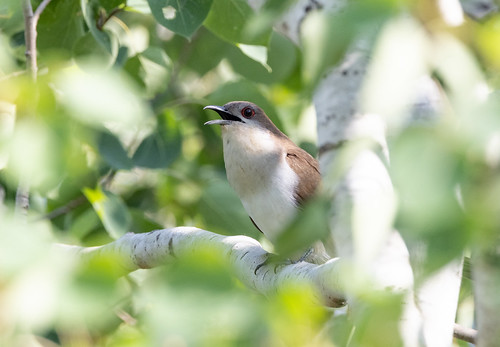 |
| Click here to hear this very bird as recorded on my iPhone. |
Both cuckoos feed voraciously on cicadas and hairy caterpillars, including gypsy moths and the tent caterpillars that are abundant this year up here, which makes this summer a time when people are noticing cuckoos. I’ve been fielding lots of questions from people who are hearing them calling incessantly, sometimes by night as well as by day.
I’ve always wished I could observe cuckoos nesting, but that would involve invading their privacy. Janice Hughes described the baby cuckoos in a charming way in the Cornell Lab of Ornithology’s Birds of the World:
Shiny, black nestlings hatch following a brief 11-day incubation period. Within 3 hours of hatching, they can raise themselves onto twigs, using their feet and bills. They mature rapidly, and at 6 days of age resemble porcupines, with their long, pointed feather sheaths. Just prior to the young leaving the nest on the following day, the sheaths burst and the chick becomes fully feathered, a process once likened to the commotion in a corn popper. The agile, young cuckoos are capable of hopping and climbing rapidly through the vegetation.
Despite their seeming abundance when we’re seeing lots of prey insects, Black-billed Cuckoos are nowhere near as abundant as they used to be. Janice Hughes wrote:
Populations have declined across its range throughout the twentieth century, with particularly severe decreases in the 1980s and 1990s. Accounts from naturalists in the late 1800s speak of flocks of cuckoos descending on caterpillar-laden trees and not departing until every insect was consumed. Caterpillar irruptions still occur, but since they have been controlled by pesticide use, cuckoos are rarely seen more than singly. It is likely that pesticides, and the concomitant reduction of prey availability, have caused Black-billed Cuckoo mortality and reduced breeding success, but these effects have never been quantified.
Little by little, people seem to be waking up to the dangers of pesticides, but then again, I thought that back on the first Earth Day, and that was over half a century ago. Knowing about cuckoos is the first step in wanting to protect them. This would be a good time to start.

